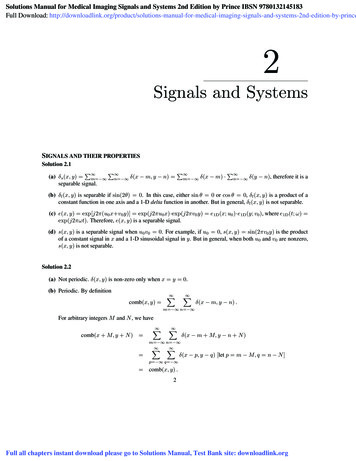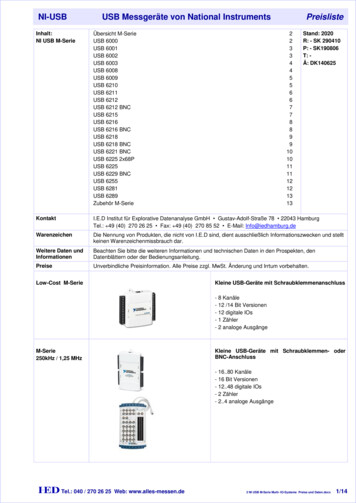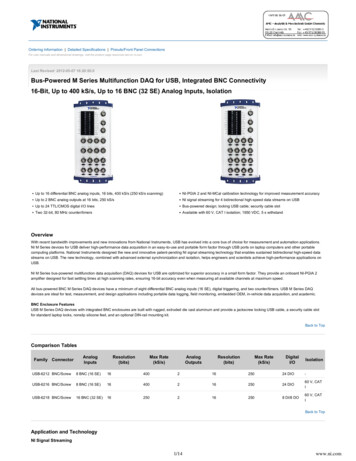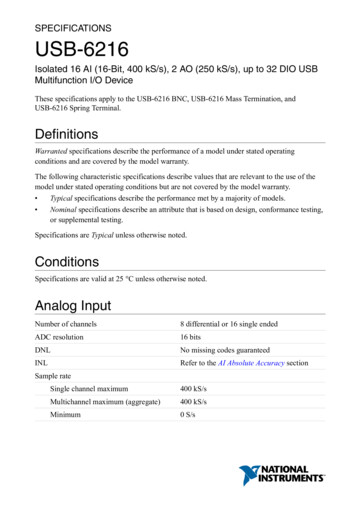
Transcription
Solutions Manual for Medical Imaging Signals and Systems 2nd Edition by Prince IBSN 9780132145183Full Download: -by-prince2Signals and SystemsSIGNALS AND THEIR PROPERTIESSolution 2.1P P P P (a) δs (x, y) m n δ(x m, y n) m δ(x m) · n δ(y n), therefore it is aseparable signal.(b) δl (x, y) is separable if sin(2θ) 0. In this case, either sin θ 0 or cos θ 0, δl (x, y) is a product of aconstant function in one axis and a 1-D delta function in another. But in general, δl (x, y) is not separable.(c) e(x, y) exp[j2π(u0 x v0 y)] exp(j2πu0 x)·exp(j2πv0 y) e1D (x; u0 )·e1D (y; v0 ), where e1D (t; ω) exp(j2πωt). Therefore, e(x, y) is a separable signal.(d) s(x, y) is a separable signal when u0 v0 0. For example, if u0 0, s(x, y) sin(2πv0 y) is the productof a constant signal in x and a 1-D sinusoidal signal in y. But in general, when both u0 and v0 are nonzero,s(x, y) is not separable.Solution 2.2(a) Not periodic. δ(x, y) is non-zero only when x y 0.(b) Periodic. By definitioncomb(x, y) X Xδ(x m, y n) .m n For arbitrary integers M and N , we havecomb(x M, y N ) X Xδ(x m M, y n N )m n XXδ(x p, y q) [let p m M, q n N ]p q comb(x, y) .2Full all chapters instant download please go to Solutions Manual, Test Bank site: downloadlink.org
3So the smallest period is 1 in both x and y directions.(c) Periodic. Let f (x Tx , y) f (x, y), we havesin(2πx) cos(4πy) sin(2π(x Tx )) cos(4πy) .Solving the above equation, we have 2πTx 2kπ for arbitrary integer k. So the smallest period for x isTx0 1. Similarly, we find that the smallest period for y is Ty0 1/2.(d) Periodic. Let f (x Tx , y) f (x, y), we havesin(2π(x y)) sin(2π(x Tx y)).So the smallest period for x is Tx0 1 and the smallest period for y is Ty0 1.(e) Not periodic. We can see this by contradiction. Suppose f (x, y) sin(2π(x2 y 2 )) is periodic; then thereexists some Tx such that f (x Tx , y) f (x, y), andsin(2π(x2 y 2 )) sin(2π((x Tx )2 y 2 )) sin(2π(x2 y 2 2xTx Tx2 )) .In order for the above equation to hold, we must have that 2xTx Tx2 k for some integer k. The solutionfor Tx depends on x. So f (x, y) sin(2π(x2 y 2 )) is not periodic.(f) Periodic. Let fd (m M, n) fd (m, n). Then π π π π sinm cosn sin(m M ) cosn .5555Solving for M , we find that M 10k for any integer k. The smallest period for both m and n is therefore10.(g) Not periodic. Following the same strategy as in (f), we let fd (m M, n) fd (m, n), and then 1111sinm cosn sin(m M ) cosn .5555The solution for M is M 10kπ. Since fd (m, n) is a discrete signal, its period must be an integerif it is to be periodic. There is no integer k that solves the equality for M 10kπ for some M . So,fd (m, n) sin 51 m cos 15 n is not periodic.Solution 2.3(a) We haveZE (δs ) Z δs2 (x, y) dx dy limlimZ X Y lim XZY X X Y m n lim (2bXc 1)(2bY c 1)X Y ,Xδ(x m, y n) dx dy
4CHAPTER 2: SIGNALS AND SYSTEMSwhere bXc is the greatest integer that is smaller than or equal to X. We also haveP (δs )limZYδs2 (x, y) dx dylim XZ X1X Y 4XY XZ1X Y 4XY lim YZ Y Xlim Xδ(x m, y n) dx dy Y m n X(2bXc 1)(2bY c 1)4XY 4bXcbY c 2bXc 2bY c1 lim lim X Y 4XY4XY4XY 1. limlimX Y (b) We haveZE (δl ) Z Z 1 Z δ(x cos θ y sin θ l) dx dy Z 1 dx, sin θ 6 0 sin θ Z E (δl )Equalityδ(ax) δ(x cos θ y sin θ l) 2 dx dy 1 cos θ .1 comes from the scaling property1 a δ(x). Suppose cos θ 6 0. Thenof the point impulse. The 1-D version of Eq. (2.8) in the text isδ(x cos θ y sin θ l) Therefore,Zdy, cos θ 6 0 1sin θlδ x y . cos θ cos θ cos θ δ(x cos θ y sin θ l)dx 1. cos θ We also haveP (δl )1 lim limX Y 4XY 1X Y 4XYlimZXZY XZ X YZ Y X Y δ(x cos θ y sin θ l) 2 dx dyδ(x cos θ y sin θ l)dx dy .limWithout loss of generality, assume θ 0 and l 0, so that we have sin θ 0 and cos θ 1. Then it follows
5thatP (δl )1X Y 4XYZ1X Y 4XYZ1X Y 4XY2Y lim limX Y 4XY1 limX 2X 0.Z lim lim limXlim XYlim YZYδ(x) dx dy(Z)Xδ(x)dx dy Y XYlim1dx Y(c) We haveZE (e) Z 2 exp [j2π(u0 x v0 y)] dx dy Z Z 1 dx dy . And alsoP (e) 1lim limX Y 4XY1X Y 4XY 1. limZXZY XZ X YZ Y X Y exp[j2π(u0 x v0 y)] 2 dx dy1 dx dylim(d) We haveZE (s) Z 2 Z Z Z Z 3 sin2 [2π(u0 x v0 y)] dx dy1 cos[4π(u0 x v0 y)]dx dy2Z Z 1cos[4π(u0 x v0 y)]dx dy dx dy22 .Equality 2 comes from the trigonometric identity cos(2θ) 1 2 sin2 (θ). Equality 3 holds becausethe first integral goes to infinity. The absolute value of the second integral is bounded, although it does not
6CHAPTER 2: SIGNALS AND SYSTEMSconverge as X and Y go to infinity. We also haveP (s) 1X Y 4XYZ1lim limX Y 4XYZlim X4 Y YZYsin2 [2π(u0 x v0 y)] dx dy Y(ZX X)1 cos[4π(u0 x v0 y)]dx dy2Y sin[4π(u0 X v0 y)] sin[4π( u0 X v0 y)]1X lim limdyX Y 4XY8πu0 Y Z Y sin(4πu0 X) cos(4πv0 y)1X lim limdyX Y 4XY4πu0 Y 2 sin(4πu0 X) sin(4πv0 Y )12XY lim limX Y 4XY(4π)2 u0 v01.2Z XlimIn order to get 4 , we have used the trigonometric identity sin(α β) sin α cos β cos α sin β. The restof the steps are straightforward.Since s(x, y) is a periodic signal with periods X0 1/u0 and Y0 1/v0 , we have an alternative way tocompute P by considering only one period in each dimension. Accordingly,P (s) Z X0 Z Y01sin2 [2π(u0 x v0 y)] dx dy4X0 Y0 X0 Y0 2 sin(4πu0 X0 ) sin(4πv0 Y0 )12X0 Y0 4X0 Y0(4π)2 u0 v0 12 sin(4π) sin(4π)2X0 Y0 4X0 Y0(4π)2 u0 v01.2SYSTEMS AND THEIR PROPERTIESSolution 2.4Suppose two LSI systems S1 and S2 are connected in cascade. For any two input signals f1 (x, y), f2 (x, y), andtwo constants a1 and a2 , we have the following:S2 [S1 [a1 f1 (x, y) a2 f2 (x, y)]] S2 [a1 S1 [f1 (x, y)] a2 S1 [f2 (x, y)]] a1 S2 [S1 [f1 (x, y)]] a2 S2 [S1 [f2 (x, y)]] .So the cascade of two LSI systems is also linear. Now suppose for a given signal f (x, y) we have S1 [f (x, y)] g(x, y), and S2 [g(x, y)] h(x, y). By using the shift-invariance of the systems, we can prove that the cascade oftwo LSI systems is also shift invariant:S2 [S1 [f (x ξ, y η)]] S2 [g(x ξ, y η)] h(x ξ, y η) .
7This proves that two LSI systems in cascade is an LSI systemTo prove Eq. (2.46) we carry out the following:g(x, y) h2 (x, y) [h1 (x, y) f (x, y)]Z Z h1 (ξ, η)f (x ξ, y η) dξ dη h2 (x, y) Z Z Z Z h1 (ξ, η)f (x u ξ, y v η) dξ dη du dvh2 (u, v) Z Z Z Z h2 (u, v)h1 (ξ, η)f (x u ξ, y v η) dξ dηdu dv ZZ Z Z h2 (u, v)f (x ξ u, y η v) du dv dξ dηh1 (ξ, η) h1 (x, y) [h2 (x, y) f (x, y)] .This proves the second equality in (2.46). By letting α u ξ, and β v η, we haveZ Z Z Z h2 (u, v)h1 (ξ, η)f (x u ξ, y v η) dξ dηdu dvg(x, y) Z Z Z Z h2 (α ξ, β η)h1 (ξ, η) dξ dη f (x α, y β) dα dβ [h1 (x, y) h2 (x, y)] f (x, y) ,which proves the second equality in (2.46).To prove (2.47) we start with the definition of convolutionZ Z g(x, y) h2 (ξ, η)h1 (x ξ, y η)dξ dη h1 (x, y) h2 (x, y) .We then make the substitution α x ξ and β y η and manipulate the resultZ Z h2 (x α, y β)h1 (α, β)( dα) ( dβ)g(x, y) Z Z Z Z h1 (α, β)h2 (x α, y β)dα dβ h1 (ξ, η)h2 (x ξ, y η)dξ dη h2 (x, y) h1 (x, y) ,where the next to last equality follows since α and β are just dummy variables in the integral.
8CHAPTER 2: SIGNALS AND SYSTEMSSolution 2.51. Suppose the PSF of an LSI system is absolutely integrable.Z Z h(x, y) dx dy C (S2.1) where C is a finite constant. For a bounded input signal f (x, y) f (x, y) B ,for every (x, y) ,(S2.2)for some finite B, we have g(x, y) h(x, y) f (x, y) Z Z h(x ξ, y η)f (ξ, η)dξdη Z Z h(x ξ, y η) · f (ξ, η) dξdη Z Z h(x, y) dx dy B BC ,for every (x, y)(S2.3)So g(x, y) is also bounded. The system is BIBO stable.2. We use contradiction to show that if the LSI system is BIBO stable, its PSF must be absolutely integrable.Suppose the PSF of a BIBO stable LSI system is h(x, y), which is not absolutely integrable, that is,Z Z h(x, y) dx dy is not bounded. Then for a bounded input signal f (x, y) 1, the output isZ Z g(x, y) h(x, y) f (x, y) h(x, y) dx dy, which is also not bounded. So the system can not be BIBO stable. This shows that if the LSI system is BIBO stable,its PSF must be absolutely integrable.Solution 2.6(a) If g 0 (x, y) is the response of the system to inputg 0 (x, y) KXPKk 1wk fk (x, y), thenwk fk (x, 1) k 1 KXKXk 1wk fk (0, y)k 1wk [fk (x, 1) fk (0, y)]k 1 KXwk gk (x, y)
9where gk (x, y) is the response of the system to input fk (x, y). Therefore, the system is linear.(b) If g 0 (x, y) is the response of the system to input f (x x0 , y y0 ), theng 0 (x, y) f (x x0 , 1 y0 ) f ( x0 , y y0 );whileg(x x0 , y y0 ) f (x x0 , 1) f (0, y y0 ).Since g 0 (x, y) 6 g(x x0 , y y0 ), the system is not shift-invariant.Solution 2.7(a) If g 0 (x, y) is the response of the system to input0g (x, y)KX PKk 1wk fk (x, y), then!KXwk fk (x, y)k 1 !wk fk (x x0 , y y0 )k 1K XKXwi wj fi (x, y)fj (x x0 , y y0 ),i 1 j 1whileKXwk gk (x, y) k 1Since g 0 (x, y) 6 KXwk fk (x, y)fk (x x0 , y y0 ).k 1PKk 1 gk (x, y),the system is nonlinear.0On the other hand, if g (x, y) is the response of the system to input f (x a, y b), theng 0 (x, y) f (x a, y b)f (x a x0 , y b y0 ) g(x a, y b)and the system is thus shift-invariant.(b) If g 0 (x, y) is the response of the system to inputg 0 (x, y)PKk 1Z wk fk (x, y), thenKXwk fk (x, η) dη k 1 KXk 1 KX Z wk fk (x, η) dη wk gk (x, y),k 1where gk (x, y) is the response of the system to input fk (x, y). Therefore, the system is linear.
10CHAPTER 2: SIGNALS AND SYSTEMSOn the other hand, if g 0 (x, y) is the response of the system to input f (x x0 , y y0 ), thenZ 0g (x, y) f (x x0 , η y0 ) dη Z f (x x0 , η y0 ) d(η y0 ) Z f (x x0 , η) dη. Since g(x x0 , y y0 ) R f (x x0 , η) dη, the system is shift-invariant.Solution 2.8From the results in Problem 2.5, we know that an LSI system is BIBO stable if and only if its PSF is absolutelyintegrable.R R (a) Not stable. The PSF h(x, y) goes to infinite when x and/or y go to infinity. h(x, y) dx dy R R 2R hR 2 iR hR 2 iR R 2(x y)dxdy xdxdy y dy dx. Since x2 dx y 2 dy R R is not bounded, then (x2 y 2 )dx dy is not bounded.hRi2R R R R 2 (b) Stable. h(x, y) dx dy (exp{ (x2 y 2 )})dx dy e x dx π, which isbounded. So the system is stable.hRiR R R R 22 (c) Not stable. The absolute integral x2 e y dx dy x2 e y dy dx πx2 dx isunbounded. So the system is not stable.Solution 2.9(a) g(x) R f (x t)f (t)dt.(b) Given an input as af1 (x) bf2 (x), where a, b are some constant, the output isg 0 (x)[af1 (x) bf2 (x)] [af1 (x) bf2 (x)] a2 f1 (x) f1 (x) 2abf1 (x) f2 (x) b2 f2 (x) f2 (x)6 ag1 (x) bg2 (x),where g1 (x) and g2 (x) are the output corresponding to an input of f1 (x) and f2 (x) respectively.Hence, the system is nonlinear.(c) Given a shifted input f1 (x) f (x x0 ), the corresponding output isg1 (x) f1 (x) f1 (x)Z f1 (x t)f1 (t)dt Z f (x t x0 )f1 (t x0 )dt.
11Changing variable t0 t x0 in the above integration, we getZ f (x 2x0 t0 )f1 (t0 )dt0g1 (x) g(x 2x0 ).Thus, if the input is shifted by x0 , the output is shifted by 2x0 . Hence, the system is not shift-invariant.CONVOLUTION OF SIGNALSSolution 2.10(a)f (x, y)δ(x 1, y 2) f (1, 2)δ(x 1, y 2) (1 22 )δ(x 1, y 2) 5δ(x 1, y 2)(b)Zf (x, y) δ(x 1, y 2) Z f (ξ, η)δ(x ξ 1, y η 2) dξ dη Z Z f (x 1, y 2)δ(x ξ 1, y η 2) dξ dηZ Z f (x 1, y 2)δ(x ξ 1, y η 2) dξ dη f (x 1, y 2) (x 1) (y 2)2(c)Z Z δ(x 1, y 2)f (x, 3)dx dy 1 Z Zδ(x 1, y 2)f (1, 3)dx dy Z Z Z δ(x 1, y 2)dx dy10 2 Equality1δ(x 1, y 2)(1 32 )dx dy Z 10comes from the Eq. (2.7) in the text. Equality 2 comes from the fact:Z Z Z Z δ(x 1, y 2)dx dy δ(x, y)dx dy 1.
12CHAPTER 2: SIGNALS AND SYSTEMS(d)δ(x 1, y 2) f (x 1, y 2) Z Z Z3Z4Z δ(x ξ 1, y η 2)f (ξ 1, η 2)dξ dη δ(x ξ 1, y η 2)f ((x 1) 1, (y 2) 2)dξ dη Z δ(x ξ 1, y η 2)f (x, y)dξ dη 5 f (x, y) x y 2 3 comes from the definition of convolution; 4 comes from the Eq. (2.7) in text; 5 is the same as 2 in part(c). Alternatively, by using the sifting property of δ(x, y) and defining g(x, y) f (x 1, y 2), we haveδ(x 1, y 2) g(x, y) g(x 1, y 2) f (x 1 1, y 2 2) f (x, y) x y2 .Solution 2.11(a)Zf (x, y) g(x, y) Z f (ξ, η)g(x ξ, y η) dξ dη Z Z f1 (ξ)f2 (η)g1 (x ξ)g2 (y η) dξ dη Z f1 (ξ)g1 (x ξ) dξf2 (η)g2 (y η) dη . Zf (x, y) g(x, y) Hence, their convolution is also separable.(b)f (x, y) g(x, y) (f1 (x) g1 (x)) (f2 (y) g2 (y)) .
13Solution 2.12g(x, y) f (x, y) h(x, y)Z Z f (x ξ, y η)h(ξ, η)dξdη Z Z (x ξ y η)exp{ (ξ 2 η 2 )}dξdη ZZ Z Z Z 2222ξe ξ η dξdη e ξ η dξdη (x y)(x y) Z ξ 2e 2dξ Z η 2 ZZ eξe ξ 2 Z dξ dη e ξ 2 ηe ξ2 η 2dξdη Z η 2ηe dη dξ π(x y)(S2.4)2We get (S2.4) by noticing that since ξ is an odd function and e ξ is an even function, we must haveZ 2ξe ξ dξ 0 . Also, Z2e ξ dξ π. FOURIER TRANSFORMS AND THEIR PROPERTIESSolution 2.13(a) See the solution to part (b) below. The Fourier transform isF2 {δs (x, y)} δs (u, v)(b)ZF2 {δs (x, y; x, y)} Z δs (x, y; x, y)e j2π(ux vy) dx dy δs (x, y; x, y) is a periodic signal with periods x and y in x and y axes. Therefore it can be writtenas a Fourier series expansion. (Please review Oppenheim, Willsky, and Nawad, Signals and Systems for thedefinition of Fourier series expansion of periodic signals.)δs (x, y; x, y) X Xm n nyCmn ej2π( x y ) ,mx
14CHAPTER 2: SIGNALS AND SYSTEMSwhereCmn 1 x yZ1 x yZ x2ZZ X Xnyδ(x m x, y n y)e j2π( x y ) dx dy.mx y2 m n x2In the integration region x2 x m 0, n 0. Therefore, we haveCmnnyδs (x, y; x, y)e j2π( x y ) dx dymx y2 y2 x2 x2 y2 x2and y2 y 1 x y Z x2 x2Z y2 y2there is only one impulse corresponding to0·yδ(x, y)e j2π( x y ) dx dy0·x y21. x y We have:δs (x, y; x, y) XXnymx1ej2π( x y ) . x y m n Therefore,ZF2 {δs } 5δs (x, y; x, y)e j2π(ux vy) dx dy Z XXnymx1ej2π( x y ) e j2π(ux vy) dx dy x y m n Z Z XXnymx1ej2π( x y ) e j2π(ux vy) dx dy x y m n X X X Xonnymx1F2 ej2π( x y ) x ym n X X1mnδ u ,v x y x ym n 1· x yδ(u x m, v y n) x ym n δs (u x, v y)5Equality Z F2 {δs }Zcomes from the property δ(ax) 1 a δ(x).
15(c)ZF2 {s(x, y)} Z s(x, y)e j2π(ux vy) dx dy Z Zsin[2π(u0 x v0 y)]e j2π(ux vy) dx dy Z Zi1 h j2π(u0 x v0 y)e e j2π(u0 x v0 y) e j2π(ux vy) dx dy 2j Z Z 1ej2π(u0 x v0 y) e j2π(ux vy) dx dy2j Z Z j2π(u0 x v0 y) j2π(ux vy)edx dye Z Z 1e j2π[(u u0 )x (v v0 )y] dx dy2j Z Z j2π[(u u0 )x (v v0 )y]edx dy F2 {s(x, y)} 1[δ(u u0 , v v0 ) δ(u u0 , v v0 )] .2jWe used Eq. (2.69) twice to get the last equality.(d)ZF2 (c)(u, v) Z c(x, y)e j2π(ux vy) dx dy Z Z Z Z 12 Zcos[2π(u0 x v0 y)]e j2π(ux vy) dx dy1 j2π(u0 x v0 y)[e e j2π(u0 x v0 y) ]e j2π(ux vy) dx dy2 Z Zej2π(u0 x v0 y) e j2π(ux vy) dx dy Z 12 Z Z j2π[(u u0 )x (v v0 )y]e Z Z F2 (c)(u, v) e j2π(u0 x v0 y) e j2π(ux vy) dx dydx dye j2π[(u u0 )x (v v0 )y] dx dy 1[δ(u u0 , v v0 ) δ(u u0 , v v0 )].2We used Eq. (2.69) twice to get the last equality.
16CHAPTER 2: SIGNALS AND SYSTEMS(e)ZF2 (f )(u, v) Zf (x, y)e j2π(ux vy) dx dy Z Z Z Z1 (x2 y2 )/2σ2 j2π(ux vy)eedx dy2πσ 2 1 (x2 j4πσ2 ux)/2σ2 (y2 j4πσ2 vy)/2σ2eedx dy2 2πσ Z Z 22222211 e (x j4πσ ux)/2σ dxe (y j4πσ vy)/2σ dy 2πσ 22πσ 2 Z 2222221 e (x j2πσ u) /2σ e(j2πσ u) /2σ dx ·2πσ 2 Z 2222221 e (y j2πσ v) /2σ e(j2πσ v) /2σ dy2πσ 2 Z 2222 2 21 e (x j2πσ u) /2σ dx · e 2π σ u2πσ 2 Z 2222 2 21 e (y j2πσ v) /2σ dye 2π σ v2πσ 2 F2 (f )(u, v) e 2π2 e 2π2σ 2 u22· e 2π22σ (u v )2σ2 v2.Solution 2.14The Fourier transform of f (x) isZ F (u) f (x)e j2πux dx. (a) Assuming f (x) is real and f (x) f ( x),Z F (u) f (x)e j2πux dx Z f (x)ej2πux dx Z f ( ξ)e j2πuξ dξ, let ξ x Z f (ξ)e j2πuξ dξ, since f ( x) f (x) and f (x) is real F (u) .
17(b) Similarly, assuming f (x) is real and f (x) f ( x),Z f ( ξ)e j2πuξ dξF (u) Z f (ξ)e j2πuξ dξ, since f ( x) f (x) F (u) .Solution 2.15In deriving the symmetric property F (u) F (u), we used the fact that f (x) is real. If f (x) is a complexsignal, we have f ( ξ) f (ξ) instead of f ( ξ) f (ξ). Therefore,Z f (x)e j2πux dxF (u) Z f ( ξ)e j2πuξ dξ, let ξ x Z f (ξ)e j2πuξ dξ, F {f (x)}Solution 2.16(a) Conjugate property: F2 (f )(u, v) F ( u, v).Z Z F2 (f )(u, v) f (x, y)e j2π(ux vy) dx dy Z Z Z Z f (x, y)ej2π(ux vy) dx dyf (x, y)e j2π[( u)x ( v)y] dx dy [F ( u, v)] F ( u, v) .Conjugate symmetry property: If f (x, y) is real, F (u, v) F ( u, v). Since f (x, y) is real, f (x, y) f (x, y). Therefore,F ( u, v) F2 {f (x, y)} F2 {f (x, y)} F (u, v) .
18CHAPTER 2: SIGNALS AND SYSTEMS(b) Scaling property: F2 (f ab )(u, v) ab1 ab F2 (f )ZF2 (f )(u, v) Z . Z u va, bf (ax, by)e j2π(ux vy) dx dy Z 1f (ax, by)e j2π[u(ax)/a v(by)/b] d(ax) d(by)ab Z Z 1f (p, q)e j2π[(u/a)p (v/b)q] dp dq ab u v 1.F2 (f ), ab a b(c) Convolution property: F2 (f g)(u, v) F2 (g)(u, v) · F2 (f )(u, v). Z Z Z Z F2 (f g)(u, v) f (ξ, η)g(x ξ, y η)dξ dη e j2π(ux vy) dx dy. Interchange the order of integration to yield Z Z Z Z j2π(ux vy)F2 (f g)(u, v) f (ξ, η)g(x ξ, y η)edx dy dξ dη Z Z Z Z f (ξ, η)g(x ξ, y η) j2π[u(x ξ) v(y η)] j2π(uξ vη)eedx dy dξ dη Z Z Z Z f (ξ, η)e j2π(uξ vη)g(x ξ, y η) e j2π[u(x ξ) v(y η)] dx dy dξ dη Z Z Z Z j2π(uξ vη) j2π[up vq] f (ξ, η)eg(p, q)edp dq dξ dη Z Z f (ξ, η)e j2π(uξ vη) F2 (g)(u, v) dξ dη Z Z F2 (g)(u, v) ·f (ξ, η)e j2π(uξ vη) dξ dη F2 (f g)(u, v) F2 (g)(u, v) · F2 (f )(u, v).
19(d) Product property: F2 (f g)(u, v) F (u, v) G(u, v).Z Z f (x, y)g(x, y)e j2π(ux vy) dx dyF2 (f g)(u, v) Z Z Z Z j2π(xξ yη)G(ξ, η)edξ dη f (x, y)e j2π(ux vy) dx dy Z Z Z Z j2π(xξ yη) j2π(ux vy)f (x, y)eedxdy dξ dηG(ξ, η) ZZ Z Z j2π[(u ξ)x (v η)y]f (x, y)edx dy dξ dηG(ξ, η) Z Z G(ξ, η)F (u ξ, v η) dξ dη F (u, v) G(u, v).Solution 2.17Since both the rect and sinc functions are separable, it is sufficient to show the result for 1-D rect and sincfunctions. A 1-D rect function is 1 1, for x 2rect(x) 0, for x 12ZF{rect(x)} rect(x)e j2πux dx Z 1/2 e j2πux dx 1/2Z1/2Z1/2cos(2πux)dx j 1/2Zsin(2πux)dx, 1/21/2 cos(2πux)dx 1/2 sin(πu)πusinc(u) .Therefore, we have F{sinc(x)} rect(u). Using Parseval’s Theorem, we haveZ Z E k rect(x, y)k2 dx dy 1/2 Z 1/2Z dx dy 1/2 1 1/2ejθ cos θ j sin θ
20CHAPTER 2: SIGNALS AND SYSTEMSFor the sinc function, P 0, because E is finite.Solution 2.18Since the signal is separable, we haveF[f (x, y)] F1D [sin(2πax)]F1D [cos(2πby)] ,1F1D [sin(2πax)] [δ (u a) δ (u a)] ,2j1F1D [cos(2πby)] [δ (v b) δ (v b)] .2So,F[f (x, y)] 1[δ(u a)δ(v b) δ(u a)δ(v b) δ(u a)δ(v b) δ(u a)δ(v b)] .4jNow we need to show that δ(u)δ(v) δ(u, v) (in a generalized way):δ(u)δ(v) 0,Therefore,Z Z Z Z f (u, v)δ(u)δ(v)du dv for u 6 0, or v 6 0 Zf (u, v)δ(u)du δ(v)dv f (0, v)δ(v)dv f (0, 0) . Based on the argument above δ(u)δ(v) δ(u, v), andF[f (x, y)] 1[δ(u a, v b) δ(u a, v b) δ(u a, v b) δ(u a, v b)] .4jThe above solution can also be obtained by using the relationship:sin(2πax) cos(2πby) 1[sin(2π(ax by)) sin(2π(ax by))] .2Solution 2.19A function f (x, y) can be expressed in polar coordinates as:f (x, y) f (r cos θ, r sin θ) fp (r, θ) .If it is circularly symmetric, we have fp (r, θ) is constant for fixed r. The Fourier transform of f (x, y) is defined as:Z Z f (x, y)e j2π(ux vy) dx dyF (u, v) Z 2πZfp (r, θ)e j2π(ur cos θ vr sin θ) r dr dθ00 Z 2π Z j2π(ur cos θ vr sin θ) fp (r, θ)edθ r dr . 00
21Letting u q cos φ and v q sin φ, the above equation becomes: Z 2πZ j2πqr cos(φ θ)edθ r dr .F (u, v) fp (r, θ)00Since F (u, v) is also circularly symmetric, it can be written as Fq (q, φ) and is constant for fixed q. In particular,Fq (q, φ) Fq (q, π/2), and therefore Z Z0 e j2πqr sin θ dθ r dr .00Now we will show that (2.108) holds.Z 2πZ j2πqr sin θedθ 2πfp (r, θ)Fq (q, φ) Fq (q, π/2) 2πZ0sin(2πqr sin θ)0πZ12πcos(2πqr sin θ)dθ j 2cos(2πqr sin θ)dθ0 2πJ0 (2πqr) .Equality 1 holds because cos( θ) cos(θ), and sin(θ) sin(θ).Based on the above derivation, we have proven (2.108).Solution 2.20The unit disk is expressed as f (r) rect(r) and its Hankel transform isZ F (q) 2πf (r)J0 (2πqr)r dr0Z 2πrect(r)J0 (2πqr)r dr01/2Z 2πJ0 (2πqr)r dr .0Now apply the following change of variabless r dr 2πqr ,s,2πqds,2πqto yieldF (q) 12πq 2ZπqJ0 (s)sds .0
22CHAPTER 2: SIGNALS AND SYSTEMSFrom mathematical tables, we note thatxZJ0 ( ) d xJ1 (x) .0Therefore,F (q)J1 (πq)2qjinc(q) . TRANSFER FUNCTIONSolution 2.21(a) The impulse response function is shown in Figure S2.1.10.80.60.40.203213021 1y0 1 2x 2 3Figure S2.1 3Impulse response function of the system. See Problem 2.21(a).(b) The transfer function of the function is the Fourier transform of the impulse response function:H(u, v) F{h(x, y)}2 F{e πx }F{e πy 2e π(u22 4v ).2/4} , since h(x, y) is separable
23Solution 2.22(a) The 1D profile of the bar phantom is: k 12 wk 12 w1,0,f (x) x x k 12 wk 32 w,where k is an integer. The response of the system to the bar phantom is:Z f (x ξ)l(ξ)dξ .g(x) f (x) l(x) At the center of the bar, we haveZg(0) f (0 ξ)l(ξ)dξ Z w/2 cos(αξ)dξ w/2 αw 2sin.α2 At the point halfway between two adjacent bars, we haveZ g(w) f (w ξ)l(ξ)dξ w/2Z Zw π/2αZ w π/2αcos(αξ)dξ cos(αξ)dξ3w/2w/22cos(αξ)dξw π/2α π i2 h αw sin sin αw .α22(b) From the line spread function alone, we cannot tell whether the system is isotropic. The line spread functionis a “projection” of the PSF. During the projection, the information along the y direction is lost.(c) Since the system is separable with h(x, y) h1D (x)h1D (y), we know thatZ l(x) h(x, y)dy Z h1D (x)h1D (y)dy .
24CHAPTER 2: SIGNALS AND SYSTEMSTherefore h1D (x) cl(x) where 1/c R h1D (y)dy. Hence,Z cl(y)dy ,1/c 1/c2 Z π/2α cos(αy)dy , π/2α1/c2Therefore, 2/α . α cos(αx) cos(αy) αx π/2 and αy π/22.h(x, y) 0otherwiseThe transfer function isH(u, v) F2D {h(x, y)} Z Z h(x, y)ej2πux dx ej2πuy dy Z Z h1D (x)h1D (y)ej2πux dx ej2πuy dy Z Z h1D (x)ej2πux dx h1D (y)ej2πuy dy Z Z h1D (x)ej2πux dxh1D (y)ej2πuy dy H1D (u)H1D (v) , which is also separable with H(u, v) H1D (u)H1D (v). We haverαH1D F1D {l(x)}2rn αx oα F1D {cos(αx)} F1D rect2πr h iπππ sinc(u α/2π) sinc(u α/2π) .2ααTherefore, the transfer function is π π iπhsinc(u α/2π) sinc(u α/2π)H(u, v) 2hα π α π isinc(v α/2π) sinc(v α/2π) .ααAPPLICATIONS, EXTENSIONS AND ADVANCED TOPICSSolution 2.23
25(a) The system is separable because h(x, y) e ( x y ) e x e y .p(b) The system is not isotropic since h(x, y) is not a function of r x2 y 2 . Additional comments: An easy check is to plug in x 1, y 1 and x 0, y 2 into h(x, y). Bynoticing that h(1, 1) 6 h(0, 2), we can conclude that h(x, y) is not rotationally invariant, and hence notisotropic.Isotropy is rotational symmetry around the origin, not just symmetry about a few axes, e.g., the x- andy-axes. h(x, y) e ( x y ) is symmetric about a few lines, but it is not rotationally invariant.When we studied the properties of Fourier transform, we learned that if a signal is isotropic then its Fouriertransform has a certain symmetry. Note that the symmetry of the Fourier transform is only a necessary, butnot sufficient, condition for the signal to be isotropic.(c) The response isg(x, y) h(x, y) f (x, y)Z Z h(ξ, η)f (x ξ, y η)dξ dη Z Z e ( ξ η ) δ(x ξ)dξ dη Z e ( x η ) dη Z x ee η dη 0 x ZeZe dη η e η dη02e x .(d) The response isg(x, y) h(x, y) f (x, y)Z Z h(ξ, η)f (x ξ, y η)dξ dη Z Z e ( ξ η ) δ(x ξ y η)dξ dη Z Z η ξ eeδ(x ξ y η)dξ dη Z e η e x y η dη . 1. Now assume x y 0, then x y η η. The range of integration in the above can be divided intothree parts (see Fig. S2.2):I. η ( , 0). In this interval, x y η η 0. η η, x y η (x y η);II. η [0, (x y)). In this interval, x y η 0 η. η η, x y η (x y η);III. η [ (x y), ). In this interval, 0 x y η η. η η, x y η x y η.
26CHAPTER 2: SIGNALS AND SYSTEMSh 0x-y h 0h 0x-y h 0h 0x-y h 0h-(x-y)0Figure S2.2 For x y 0 the integration interval ( , ) can be partitioned into three segments. See Problem 2.23(d).Based on the above analysis, we have:Z g(x, y) e η e x y η dη 0Ze ( η x y η ) dη ex y 2η dη e ( η x y η ) ZZ e ( η x y η ) (x y)00Z (x y)Z (x y)ex y dη Z e (x y 2η) dη (x y)01 x y1 (x y)ex y ex ye22[1 (x y)]ex y .2. For x y 0, η x y η. The range of integration in the above can be divided into three parts (seeFig. S2.3):h 0x-y h 0h 0x-y h 0h 0x-y h 0-(x-y)h0Figure S2.3 For x y 0 the integration interval ( , ) can be partitioned into three segments. See Problem 2.23(d).I. η ( , (x y)). In this interval, η x y η 0. η η, x y η (x y η);II. η [ (x y), 0). In this interval, η 0 x y η. η η, x y η x y η;III. η [0, ). In this interval, 0 η x y η. η η, x y η x y η.Based on the above analysis, we have:Z g(x, y) e η e x y η dη (x y)Ze ( η x y η ) dη Z Z e ( η x y η ) (x y) (x y) 0ex y 2η dη Z0e (x y) dη (x y)11 (x y)e (x y)e (x y) e (x y)22[1 (x y)]e (x y) .Z e ( η x y η )0Z0 e (x y 2η) dη
27Based on the above two steps, we have:g(x, y) (1 x y )e x y .Solution 2.24(a) Yes, it is shift invariant because its impulse response depends on x ξ.(b) By linearity, the output isg(x) e (x 1)22 e (x)22 e (x 1)22.Solution 2.25(a) The impulse response of the filter is the inverse Fourier transform of H(u), which can be written as uH(u) 1 rect.2U0Using the linearity of the Fourier transform and the Fourier transform pairsF {δ(t)} 1,F {sinc(t)} rect(u) ,we haveh(t) F 1 {H(u)}δ(t) 2U0 sinc(2U0 t) .(b) The system response to f (t) c is 0, since f (t) contains only a zero frequency component while h(t)passes only high frequency components. Formal proof:f (t) h(t) f (t) [δ(t) 2U0 sinc(2U0 t)] f (t) 2U0 f (t) sinc(2U0 t)Z c c2U0 sinc(2U0 t)dt Z c csinc(τ )dτ 0.
28CHAPTER 2: SIGNALS AND SYSTEMS The system response to f (t) f (t) h(t)1, t 0is0, t 0 f (t) [δ(t) 2U0 sinc(2U0 t)] f (t) 2U0 f (t) sinc(2U0 t)Z f (t) f (x)2U0 sinc(2U0 (t x))dx Z f (t) 2U0 sinc(2U0 (t x))dx0Z 2U0 sinc(2U0 (y))dy f (t) tZ t2U0 sinc(2U0 (y))dy f (t) Z 0Z 0 1 2Usinc(2U(y))dy 2U0 sinc(2U0 (y))dy 00 tZ 0Z t 1 2U0 sinc(2U0 (y))dy 2U0 sinc(2U0 (y))dy 0 Z 01 2U0 sinc(2U0 (y))dyt 0 2tZ t 1 1 2U0 sinc(2U0 (y))dy t 020 Z 01 2U0 sinc(2U0 (y))dy t 0 2tZ t 1 2U0 sinc(2U0 (y))dy20t 0.t 0t 0
29Solution 2.26(a) The rect function is defined as rect(t) So we haverectand rectTherefore,1, t 1/2.0, otherwise t1, t T /2 0, otherwiseTt 0.75T0.5T 1/T, 1/T,h(t) 1/T, 0,1, t 0.75T T /4.0, otherwise T t T /2 T /2 t T /2.T /2 t TotherwiseThe impulse response is plotted in Fig. S2.4.Figure S2.4The impulse response h(t). See Problem 2.26(a).R The absolute integral of h(t) is h(t) 2 dt 2/T . So The system is stable when T 0. The system isnot causal, since h(t) 6 0 for T t 0.(b) The response of the system to a constant signal f (t) c isZ Zg(t) f (t) h(t) f (t τ )h(τ )dτ c h(τ )dτ 0 . (c) The response of the system to the unit step function isZ Zg(t) f (t) h(t) f (t τ )h(τ )dτ t 0,t T t/T 1, T t T /2t/T, T /2 t T /2g(t) t/T 1,T /2 t T 0,t TThe response of the system to the unit step signal is plotted in Figure S2.5.h(τ )dτ
CHAPTER 2: SIGNALS AND SYSTEMSFigure S2.5The response of the system to the unit step signal. See Problem 2.26(c).(d) The Fourier transform of a rect function is a sinc function (see Problem 2.17). By using the properties of theFourier transform (scaling, shifting, and linearity), we haveH(u) F {h(t)} 0.5e j2πu( 0.75T ) sinc(0.5uT ) sinc(uT ) 0.5e j2πu(0.75T ) sinc(0.5uT ) sinc(uT ) cos(1.5πuT ) sinc(0.5uT ) .(e) The magnitude spectrum of h(t) is plotted in Figure S2.6.1.41.2T 0.25T 0.1T 0.051 H(u) 300.80.60.40.20 20 15 10 505101520uFigure S2.6The magnitude spectrum of h(t). See Problem 2.26(e).(f) From the calculation in
2 Signals and Systems SIGNALS AND THEIR PROPERTIES Solution 2.1 (a) s(x;y) P 1 m 1 P 1 n 1 (x m;y n) P 1 m 1 (x m) P 1 n 1 (y n), therefore it is a separable signal. (b) l(x;y) is separable if sin(2 ) 0.In this case, either sin 0 or cos 0, l(x;y) is a product of a constant function in one axis and a 1-D delta function in another.











